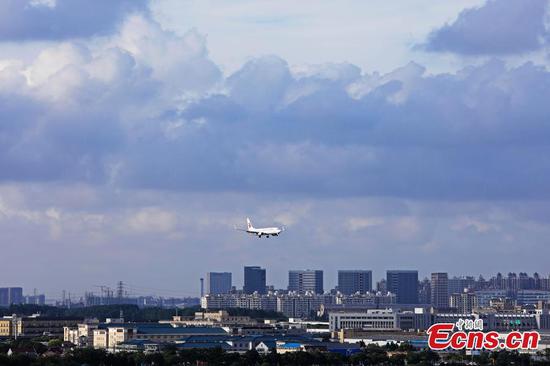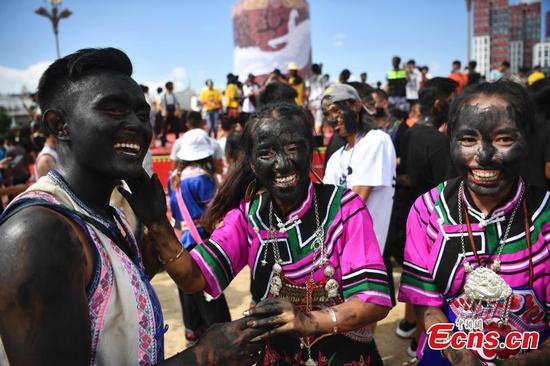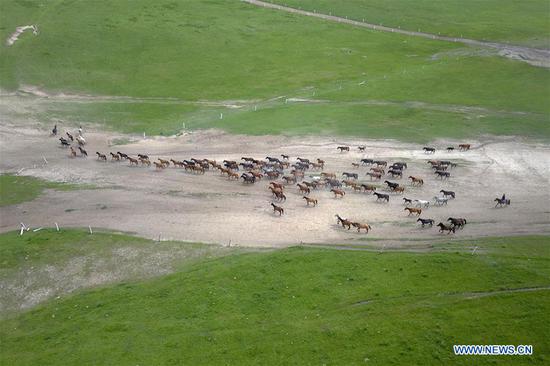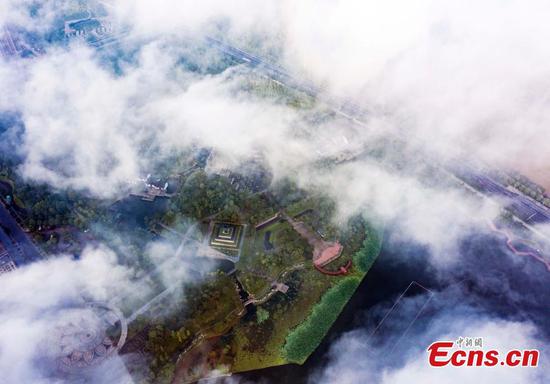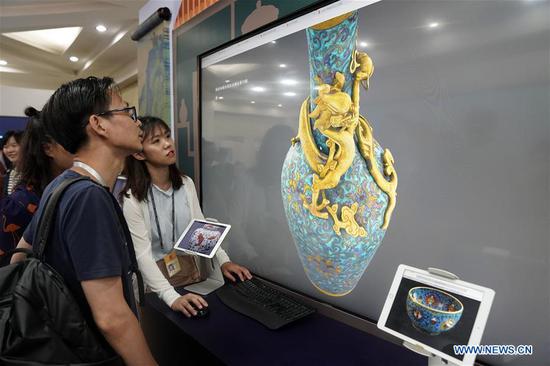VI. Multiple Religions Have Long Coexisted in Xinjiang
China has long been a multi-religious country. In addition to several major religions that are structured in accordance with strict religious norms, a variety of folk beliefs are also popular in China. Among these, Taoism and local folk beliefs are native to China, while all other religions were introduced from foreign countries. The history of Xinjiang shows that multiple religions have long coexisted there, with one or two predominant. The region’s religious structure is characterized by blending and coexistence.
The formation and evolution of the coexistence of multiple religions in Xinjiang has been a long process:
• Prior to the 4th century BC, primitive religion was widespread in Xinjiang.
•Around the 1st century BC, Buddhism was introduced into Xinjiang.
•From the 4th to 10th centuries, Buddhism reached its peak, while Zoroastrianism proliferated throughout Xinjiang.
•During the late 16th century and early 17th century, Tibetan Buddhism thrived in northern Xinjiang.
•Around the 5th century, Taoism spread into Xinjiang, prevalent in Turpan and Hami areas. During the Qing Dynasty, it revived in most parts of Xinjiang.
•In the 6th century, Manichaeism and Nestorianism entered Xinjiang. From the 10th to 14th centuries, Nestorianism flourished as the Uighur and some other peoples converted to it.
In the late 9th century and early 10th century, the Kara-Khanid Khanate accepted Islam. It started a 40-year-long religious war in the mid-10th century against the Buddhist Kingdom of Khotan, and conquered it in the early 11th century and imposed Islam there, putting an end to the thousand-year history of Buddhism in that region. With the expansion of Islam, Zoroastrianism, Manichaeism, and Nestorianism declined. In the mid-14th century, the rulers of the Eastern Chagatai Khanate (1348-1509) spread Islam to the northern edge of the Tarim Basin, the Turpan Basin and Hami through war and duress. By the early 16th century, many religions had coexisted in Xinjiang, with Islam predominant, Zoroastrianism, Manichaeism, and Nestorianism gone, and Buddhism and Taoism surviving. The coexistence has continued to this day in the region. In the early 17th century, the Oirat Mongols accepted Tibetan Buddhism. Beginning in the 18th century, Protestantism, Catholicism, and the Eastern Orthodox Church reached Xinjiang.
Xinjiang now has multiple religions, including Islam, Buddhism, Taoism, Protestantism, Catholicism, and the Eastern Orthodox Church. It has 24,800 venues for religious activities, including mosques, churches, Buddhist and Taoist temples, with 29,300 religious staff. Among these, there are 24,400 mosques, 59 Buddhist temples, 1 Taoist temple, 227 Protestant churches (or meeting grounds), 26 Catholic churches (or meeting grounds), and 3 Orthodox churches (or meeting grounds).
China, along with most other countries, upholds separation of religion from government. No religious organization is allowed to interfere in political and government affairs. No individual or organization is allowed to use religion to interfere in administration, judicial affairs, education, marriage and birth control, to hinder social order, work order and life order, to oppose the Communist Party of China and China’s socialist system, or to undermine ethnic solidarity and national unity.
Xinjiang fully respects and protects freedom of religious belief as stipulated in the Constitution of the PRC. Xinjiang respects citizens’ freedom to believe in, or not to believe in, any religion. Xinjiang shows zero tolerance to any action that creates disputes between believers and non-believers, between believers of different religions, and between believers of different sects of a religion. Xinjiang always upholds equality for all religions, showing neither favoritism towards nor discrimination against any religion and allowing no religion to be superior to any other religion. Xinjiang always upholds equality for all individuals before the law. Believers and non-believers enjoy equal rights and obligations, and all law violators, whatever their social background, ethnicity, and religious belief, will be punished in accordance with the law.
To survive and develop, religions must adapt to their social environment. The history of religions in China shows that only by adapting themselves to the Chinese context can they be accommodated within Chinese society. The 70-year history of the PRC also shows that only by adapting to socialist society can religions in China develop soundly. We must uphold the principle of independence and self-management of China’s religious affairs, and prevent all religious tendency that seeks to divest itself of all Chinese elements. We must develop and encourage secular, modern and civilized ways of life, and abandon backward and outdated conventions and customs. We must carry forward religious practices adapted to Chinese society, inspire various religions in China with core socialist values and Chinese culture, foster the fusion of religious doctrines with Chinese culture, and lead these religions, including Islam, onto the Chinese path of development.
VII. Islam Is Neither an Indigenous nor the Sole Belief System of the Uygurs
Primitive religion and Shamanism were practiced by the ancestors of the Uygurs before Zoroastrianism, Buddhism, Manichaeism, Nestorianism and Islam were introduced into the region. During the period spanning the Tang and Song dynasties, Buddhism was the predominant religion practiced by the nobility and the common people in the Uighur Kingdom of Gaochang and the Kingdom of Khotan. Many Uighurs converted to Nestorianism during the Yuan Dynasty. Today in Xinjiang, a significant number of people do not follow any religion, and many Uygurs follow religions other than Islam.
The introduction of Islam into Xinjiang was related to the emergence of the Arab Empire and the eastward expansion of Islam. The Uighur conversion to Islam was not a voluntary choice made by the common people, but a result of religious wars and imposition by the ruling class, though this fact does not undermine our respect for the Muslims’ right to their beliefs. Islam is neither an indigenous nor the sole belief system of the Uygur people.
In the process of accepting Islam, the ancestors of the Uygurs and Kazaks integrated it with local faiths and traditions, while absorbing the cultures of other ethnic groups in the region and from inland areas. Some of their religious concepts, rituals and customs remained as they evolved. Through interaction with these elements, Islam in Xinjiang gradually developed distinct local and ethnic features. For example, orthodox Islam does not allow the worship of anyone or anything other than Allah. However, the Uygurs and some other ethnic groups still venerate mazars, which are mausoleums or shrines, typically of saints or notable religious leaders. Mazar worship is a prominent example of the localization of Islam in Xinjiang. The practice of erecting long poles around the mazars, hung with streamers and sheepskin, is a result of influence from multiple religions including Shamanism and Buddhism. As another example, the Baytulla Mosque in Yining and the Shaanxi Mosque in Urumqi, both first built in Emperor Qianlong’s reign (1736-1795) during the Qing Dynasty, are characterized by beam-column construction which was common in inland areas. This embodies a form of localization of Islam.
It should be noted that since the late 1970s and early 1980s, and in particular since the end of the Cold War, the surge in religious extremism around the world has caused a rise in religious extremism in Xinjiang. This has resulted in an increasing number of incidents of terror and violence that pose a serious danger to social stability and to the lives and property of people in the region. Under the guise of religion, religious extremism trumpets theocracy, religious supremacism, actions against “pagans”, and “holy wars”. It instigates terror and violence and incites hostility between different ethnic groups, running counter to the teachings concerning patriotism, peace, solidarity, the golden mean, tolerance, and good works advocated by Islam and many other religions. Religious extremism, which constitutes the ideological base of ethnic separatism and terrorism, is by nature anti-human, anti-society, anti-civilization, and anti-religion. It is a betrayal of religion and should never be confused with religious matters, or be glossed over or excused through religious rhetoric. Drawing lessons from international experiences and in view of reality of the region, Xinjiang has taken resolute action to fight terrorism and extremism in accordance with the law, effectively clamp down on terrorism and violence and the spread of religious terrorism. Through these efforts Xinjiang has responded to the public’s expectation of security for all ethnic groups, protected the basic human rights, and maintained social harmony and stability in the region. Xinjiang’s fight against terrorism and extremism is a battle for justice and civilization against evil and barbaric forces. As such it deserves support, respect and understanding. Some countries, organizations and individuals that apply double standards to terrorism and human rights have issued unjustified criticism of Xinjiang’s effort. This kind of criticism betrays the basic conscience and justice of humanity, and will be repudiated by all genuine champions of justice and progress.














